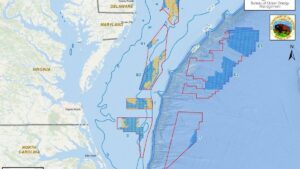
The Bureau of Ocean Energy Management (BOEM) has unveiled eight draft wind energy areas (WEAs) offshore the central Atlantic coast of the US with capacity for more than 20 GW of offshore wind.
The draft WEAs cover approximately 1.7 million acres offshore North Carolina, Virginia, Maryland, and Delaware, with their closest points ranging from approximately 19 to 77 nautical miles off the US central Atlantic coast.
BOEM director Amanda Lefton said, “As BOEM moves forward to identify wind energy areas in the central Atlantic, we continue to prioritize a robust and transparent process, including early engagement with Tribal governments, state and federal agencies and ocean users.
“We want to gather as much information and traditional knowledge as possible to help us identify WEAs, the offshore areas that are most suitable for commercial wind energy activities while having the fewest apparent environmental and user conflicts.”
BOEM used a comprehensive process to identify the potential offshore locations that appear most suitable for renewable energy development, taking into consideration possible impacts to local resources and ocean users. It collaborated with the National Oceanic and Atmospheric Administration’s National Centers for Coastal Ocean Science to use an ocean planning model that seeks to minimize conflicts.
The eight draft WEAs represent a subset of the original 3.9 million acres of the call area that the Department of the Interior announced for public comment in April 2022.
The final WEAs may be further modified after incorporating feedback from government partners, ocean users, and stakeholders. BOEM is seeking comment on potential conflicts with the draft areas, including with a potential US Coast Guard fairway for transiting vessels, commercial fishing, a NASA danger zone, and marine habitat areas.
BOEM intends to further explore these areas with the Department of Defense, Coast Guard, NASA, and other ocean users, such as the fishing industry, to collect additional information that should be considered before finalizing the WEAs.
The next step in BOEM’s renewable energy leasing process offshore the central Atlantic coast is a 30-day public comment period that started on 16 November 2022. During the comment period, BOEM will hold virtual meetings to engage the fishing community and environmental organizations to gather more information on the WEAs and discuss next steps. These meetings will be open to the public.
Responding to the announcement about the draft WEAs, American Clean Power Association vice president for offshore wind Josh Kaplowitz said, “It is especially significant that five of the eight draft WEAs identified are in shallow waters that allow for the use of offshore wind turbines with fixed bottom foundations.
“These areas represent our best chance to extend the fixed bottom project pipeline on the East Coast that will spark further supply chain investments in the mid-Atlantic and help meet current and anticipated state and federal offshore wind and greenhouse gas reduction goals.
“Developing offshore wind in these areas has the potential to generate approximately 20.6 GW of reliable, domestic clean energy, which is enough to power 7.2 million homes.
“This development will also bring skilled jobs, unlock investment, and create supply chain and manufacturing opportunities to the region. At the national level, the further development of offshore wind in the Central Atlantic will help the US meet its goal of deploying 30 GW of offshore wind by 2030 and demonstrates the administration’s continued dedication to generating clean, affordable, and secure sources of domestic energy.”
National Ocean Industries Association president Erik Milito said the central Atlantic WEAs would provide states along the Central Atlantic with a chance to become part of the next wave of offshore wind hubs.
“While these states will clearly benefit tremendously from jobs and investment associated with offshore wind development, the benefits will stretch across our nation,” he said, describing offshore wind as “a national endeavour with national benefits.”
